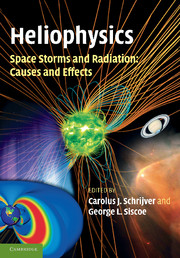Book contents
- Frontmatter
- Contents
- Preface
- 1 Perspective on heliophysics
- 2 Introduction to space storms and radiation
- 3 In-situ detection of energetic particles
- 4 Radiative signatures of energetic particles
- 5 Observations of solar and stellar eruptions, flares, and jets
- 6 Models of coronal mass ejections and flares
- 7 Shocks in heliophysics
- 8 Particle acceleration in shocks
- 9 Energetic particle transport
- 10 Energy conversion in planetary magnetospheres
- 11 Energization of trapped particles
- 12 Flares, coronal mass ejections, and atmospheric responses
- 13 Energetic particles and manned spaceflight
- 14 Energetic particles and technology
- Appendix I Authors and editors
- List of illustrations
- List of tables
- References
- Index
- Plate section
4 - Radiative signatures of energetic particles
Published online by Cambridge University Press: 05 April 2013
- Frontmatter
- Contents
- Preface
- 1 Perspective on heliophysics
- 2 Introduction to space storms and radiation
- 3 In-situ detection of energetic particles
- 4 Radiative signatures of energetic particles
- 5 Observations of solar and stellar eruptions, flares, and jets
- 6 Models of coronal mass ejections and flares
- 7 Shocks in heliophysics
- 8 Particle acceleration in shocks
- 9 Energetic particle transport
- 10 Energy conversion in planetary magnetospheres
- 11 Energization of trapped particles
- 12 Flares, coronal mass ejections, and atmospheric responses
- 13 Energetic particles and manned spaceflight
- 14 Energetic particles and technology
- Appendix I Authors and editors
- List of illustrations
- List of tables
- References
- Index
- Plate section
Summary
Sunspots, the white light manifestation of solar active regions, were first observed through telescopes in 1610 by Galileo and Harriot, but it was not until nearly 250 years later that the flare phenomenon was first observed by Carrington (1859), who noted a white light “conflagration” in a sunspot group (see Fig. 2.2) and speculated (correctly) that it originated above the sunspot group. It was not for almost another century – during the post-war years of the late 1940s – that solar observations strayed outside the confines of the visible spectrum into invisible wavelengths both longward (radio) and shortward (X-rays) of visible light. The launch of the Sputnik 1 satellite in late 1957 ushered in the space age which, for the first time, made vast portions of the electromagnetic spectrum accessible for sustained study. Over the last half-century, extraordinary progress has been made in developing successive generations of both ground- and space-based instrumentation to characterize and to understand radiative signatures of both quiescent and energetic processes on the Sun and in the heliosphere, although gaps remain. In this chapter we discuss radiation from energetic particles, with an emphasis on the radio, hard X-ray (HXR), and λ-ray wavelength bands. For it is in these bands that radiative signatures of the most energetic particles, those accelerated by violent processes on the Sun and in the heliosphere, are detected. In other words, the focus is on the extreme frontiers of the electromagnetic spectrum, on the extreme departures from equilibrium conditions, and on the extreme energies involved.
- Type
- Chapter
- Information
- Heliophysics: Space Storms and Radiation: Causes and Effects , pp. 79 - 122Publisher: Cambridge University PressPrint publication year: 2010
- 2
- Cited by

